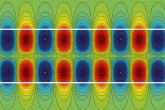Electromagnetic theory
The research is focused on the basic macroscopic electromagnetic laws as they apply to the generation and propagation of electromagnetic effects in vacuum, in material media, and in all the various devices that may be constructed to enhance, control, and utilize such effects. Thus the use and further development of all the methods - analytic, numerical, and also experimental - which are relevant for such an endeavour, are of prime interest to us.

Somewhat more specifically, the main thrust of our research effort is in the area of propagation and scattering of electromagnetic waves. Progress in this area is crucial to the development of the various tools that are used so frequently in what is broadly referred to as the information society. This trend in modern society makes us increasingly dependent upon electromagnetic waves as carriers of information.
One of our main areas of research is direct and inverse scattering problems, both in the time and the frequency domain. In a direct scattering or propagation problem one considers the problem of determining the behaviour of an electromagnetic wave as it encounters an object or medium with known electromagnetic properties. In an inverse problem on the other hand, one analyses the way in which an electromagnetic wave has changed after it has passed through an unknown medium, and from this information one tries to infer the elec-tromagnetic properties of the medium. The proper understanding of electromagnetic information gathering devices (such as sensors) typically requires that one is able to solve, to some degree, a problem of the inverse type. Furthermore, design problems have much in common with inverse problems. The theoretical work ranges from studies of basic mathematical properties to numerical implementation of models relevant for specific applications.
Non-linear effects are of great importance in many electromagnetic contexts, particularly in the context of high speed transmission over optical fibers. Progress in the theory of soliton propagation in such systems is then of obvious interest and the Division has recently become involved in basic research in that area. In addition to the greater mathematical understanding of nonlinear effects, such as uniqueness, well-posedness, blowups and asymptotics of the a number of nonlinear equations, we add physical understanding of complex nonlinear phenomena, both in electromagnetics as well as in other areas of physics. Dynamics and effective equations of several types of solitary waves has been the main focus for the last years. An increased focus on selected electromagnetic applications is foreseen.
